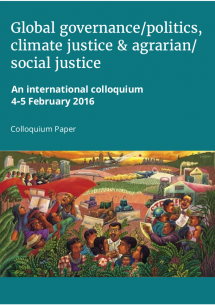Large-scale forest plantations for climate change mitigation? New frontiers of deforestation and land grabbing in Cambodia Colloquium Paper No. 11
Topics
The desperate search for ways to combat climate change gives rise to new mitigation policies and projects, such as the support of large-scale ‘sustainable ’ forestry plantations. However, climate justice and climate mitigation cannot be met as long as large-scale industrial plantations continue to marginalise small-scale indigenous forest users who actively protect biodiverse forests.

Downloads
Authors
The desperate search for ways to combat climate change gives rise to new mitigation policies and projects, with questionable impacts on people and the environment. Among these mitigation projects is the increasing support of large-scale ‘sustainable ’ forestry plantations as part of the broader Clean Development Mechanisms.
This paper discusses several problems that may arise from such plantation projects, especially the missed mitigation potential through the involvement of local actors in protecting biodiverse forests. It draws on an empirical case study of a 34,007ha forest reforestation project granted by the Royal Government of Cambodia (RGC) to a private Korean company. Located at the edge of the unique Prey Lang forest in an area of dense forest cover, this forest restoration project will “promote sustainable resource use” by “reducing local slash-and-burn activities” and actively “participating in Clean Development Mec hanisms”, according to the RGC documents.
On the ground, the forest restoration project is causing widespread deforestation through active forest clear-cutting that includes burning the vegetation after the removal of market-bound timber. First and foremost, this act of Clean Development reduces current forest carbon stocks and increases greenhouse gas emissions. Moreover, this so-called ‘sustainable forestry’ project comes with vast environmental and social costs, including the transformation of diverse forests to industrial monocultures, the marginalization of indigeno us slash-and-burn agriculture, land grabs, and the exclusion of small-scale forest users from crucial livelihood resources. At the same time, the grassroots Prey Lang Community Network active in forest patrols to stop deforestation in the area is confronted by the legalized clearing of forests it was recently protecting. The arbitrary character of climate change mitigation policies challenges the ability of grassroots forest protection activists to do their self-appointed jobs, which they say is, “protecting the forest for themselves, their grandchildren, and for all the people of the world.”
Climate justice and climate change mitigation for present and future generations will be impossible as long as large-scale industrial plantations continue to deforest vast landscapes in the name of clean development and small-scale indigenous forest users who actively protect biodiverse forests continue to be marginalized.
* This paper was published as part of the 2 day Colloquium Global governance/politics, climate justice & agrarian/social justice and selected for republishing on the TNI website. All papers can be found at the website of ISS.